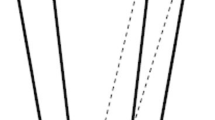Abstract
Loading and haulage costs make up the majority of the expenses—almost half of its total costs at many mines. At many mines, loading and haulage costs make up the majority of the expenses—almost half of its total costs, in fact. Many researchers believe that the properties of fragmented rock are one of the most important factors that affect the productivity of loading machines. The purpose of this paper is to study the effects of fragmented rock properties on the penetration rate of a loader’s bucket as one of the parameters of loading productivity. The study will be done using a simulated loader in the laboratory. For the study, 25 samples of fragmented rock with previously defined Rosin–Rammler’s size-distribution function, including the defined mean particle size (d50) and uniformity index (n), were built. Then, bulk-specific gravity and angle of repose of the samples were measured using standard laboratory tests. The relation of n and d50 and the measured properties of the samples with each other and with the penetration rate of the loader’s bucket were analysed. The results showed high correlation between pre-determined size distribution parameters and the measured properties of fragmented rock, including bulk-specific gravity and angle of repose. Also, the penetration rate is inversely correlated to the uniformity index, the angle of repose, and consequently, internal friction angle. And, it is in direct correlation with the mean particle size of the fragmented rocks and bulk specific gravity. It is obvious from the results that uniformity has more effect on the penetration rate than the mean particle size does.


















Similar content being viewed by others
References
American Society for Testing and Materials (2000) Stanndard test method for measuring the angle of repose of free-flowing mold powders, C pp 1444–14499
Blair D (2004) Curve-fitting schemes for fragmentation data. In: Fragblast conference
Brunton I, Thornton D, Hodson R, Sprott D (2003) Impact of blast fragmentation on hydraulic excavator dig dime. In: Proceeding of fifth large open pit mining conference
Chung SH, Lee HN, Hunter CJ (1991) A blast design analysis for optimizing productivity at inco limited’s thompson open pit. Int Soc Explos Eng 02:119
Doktan M (2001) Impact of blast fragmentation on truck shovel fleet performance. 17th International mining congress and exhibition of Turkey-IMCET, p 375
Ghazikalayeh AR, Amirafshari M, Mkrchyan H, Taji M (2013) Application of fuzzy hybrid analytic network process in equipment selection of open-pit metal mines. Int J Res Ind Eng 2:35–46
Hanspal S, Scoble M, Lizotte Y (1995) Anatomy of a blast muckpile: influence on loading machine performance. Int Soc Explos Eng, p 57
Hendricks C, Scoble M, Peck J (1989) Performance monitoring of electric mining shovels. Inst Min Metall 98:A151–A159
Hustrulid W, Kuchta M, Martin R (2013) Open pit mine planning and design, two volume set & CD-ROM pack, 3rd edn. CRC Press, Baca Raton
Kahriman A, Özer Ü, Karadogan A, Özdemir K, Tuncer G, Kaya E (2008) Effect of particle size distribution on loading performance. Int Soc Explos Eng 34:279
MacKenzie A (1967) Optimum blasting. In: Proceedings of the 28th annual minnesota mining symposium
McGill MD, Freadrich J (1994) The effect of fragmentation on loader productivity. Int Soc Explos Eng, p 173
Meulenkamp F, Alvarez M (1999) Grima, application of neural networks for the prediction of the unconfined compressive strength (UCS) from Equotip hardness. Int J Rock Mech Min Sci 36:29
Oraee K, Asi B (2006) Use of solution strategy in open cast mining truck. In: 5th international symposium on mine planning and design
Osanloo M, Hekmat A (2005) Prediction of shovel productivity in the Gol-E-Gohar iron mine. J Min Sci 41:177
Özdemir K, Tuncer G, Kahriman A, Özer Ü, Karadogan A (2007) The relation between excavator bucket loading time and particle size distribution of shot rock. Int Soc Explos Eng 33:303
Sanchidrian J, Ouchterlony F, Moser P, Seggara P, Lopez L (2011) On loader productivity: rock strength and explosive energy in metal mining. In: 6th EFEE world conference on explosives and blasting, Portugal
Sarı M, Lever P (2007) Effect of blasted rock particle size on excavation machine loading performance. In: 20th intenational mining congress and exhibition of Turkey, ISBN, no. ISBN, pp 978–9944
Sarkar K, Tiwary A, Singh T (2010) Estimation of strength parameters of rock using artificial neural networks. Bull Eng Geol Environ 69:599–606
Scoble MJ, Lizotte Y, Hendricks C, Mohanty B (1991) Fragmentation interaction with underground mining systems and productivity. Int Soc Explos Eng, p 79
Singh S, Narendrula R (2005) Characteristics of the blasted muck and the loaders’ productivity. In: International socity of explosive engineering, 31st international conference on explosives and blasting techniques, Orlando, FL, USA, pp 347–353
Singh S, Narendrula R (2006) Factors affecting the productivity of loaders in surface mines. Int J Min Reclam Environ 20:20–32
Singh S, Yalchin T (2002) Effect of muck sizes distribution on scooping operations. Int Soc Explos Eng 1:315
Singh S, Yalchin T, Glogger M, Narendrula R (2003) interactions between the size distribution of the muck and the loading equipment. In: Proceeding of 4th international Conference on computer applications in mineral industries, Canada
Singh S, Narendrula R, Duffy D (2005) Influence of blasted muck on the performance of loading equipment. In: Brighton conference proceeding, p 347
Terzaghi K, Peck R, Mesri G (1996) Soil mechanics in engineering practice. Wiley, Hoboken
Tosun A, Konak G (2013) Estimation of loader capacity based on the heap size distribution calculated by using numerical models. J Min Sci 49:441–449
Tosun A, Konak G, Karakus D, Onur A, Toprak T (2012) Investigation of the relationship between blasting pile density and loader productivity. Rock Fragm Blast Fragblast 10:385
Author information
Authors and Affiliations
Corresponding author
Rights and permissions
About this article
Cite this article
Mirabedi, S.M.M., Khodaiari, A., Jafari, A. et al. The Effect of Important Fragmented Rock Properties on the Penetration Rate of Loader Bucket. Geotech Geol Eng 36, 1295–1307 (2018). https://doi.org/10.1007/s10706-017-0393-7
Received:
Accepted:
Published:
Issue Date:
DOI: https://doi.org/10.1007/s10706-017-0393-7




